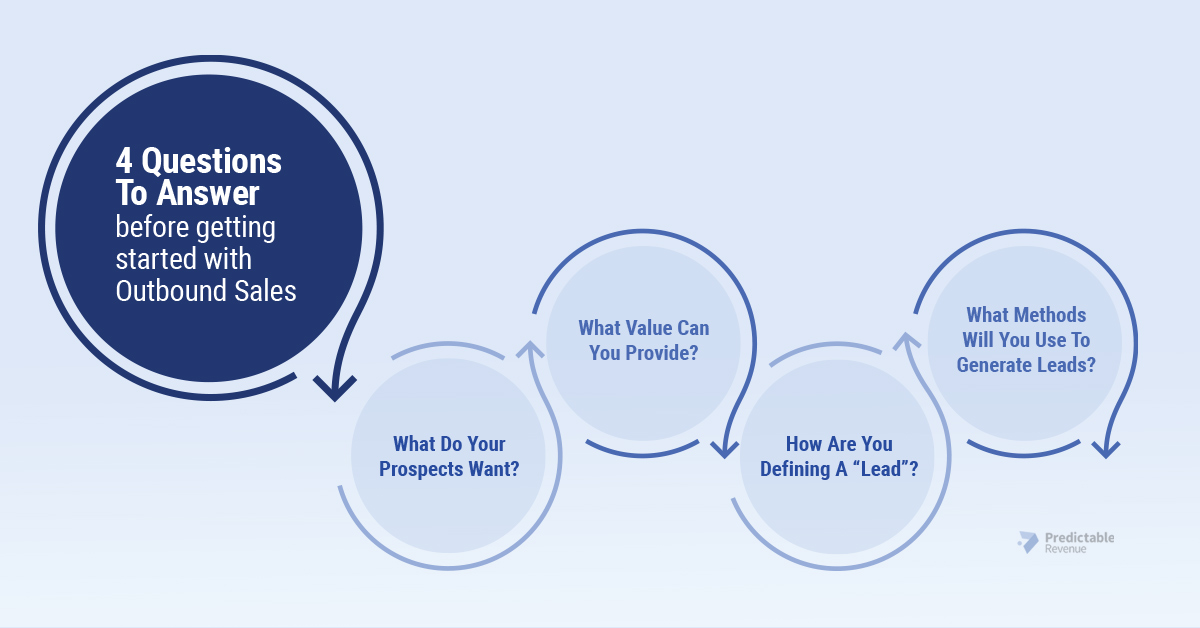Outbound Sales 101: Lead Generation For High-Level Executives

Things change rapidly in today’s high-paced business world. But one thing that is unlikely to ever change is the constant need for new customers. They are essential for company survival and growth.
Increasingly, businesses have been relying on inbound sales teams to generate leads. But to truly maximize your potential, you need to go out and find leads as well rather than solely waiting for them to find you. In this regard, your outbound sales strategies are critical to long-term, sustainable success.
We discuss the key aspects of outbound sales lead generation to help you drive revenue growth in the following article.
The Importance Of Lead Generation In The Sales Funnel
Lead generation is the lifeblood of your sales funnel. By increasing your visibility, building credibility and trust, and generating interest in your products or services through high-quality prospects, you put your business in the best position to maximize revenue and growth. But how exactly does lead generation translate to long-term sustainable success for your business? Here’s how. Lead generation:
- Boosts brand awareness, which is essential to increasing prospects at the top of the sales funnel.
- Builds targeted communities that are more receptive of your communications.
- Increases your ability to reach target prospects that are more likely to convert into customers.
- Can lead to the establishment of mutually beneficial partnerships with other businesses, thus adding another source of lead traffic.
- Ultimately plays a critical role in elevating brand loyalty and boosting overall profitability.
How To Start Outbound Lead Generation

Before getting started on your outbound lead generation efforts, make sure you can fully answer these 4 qurstions:
What Do Your Prospects Want?
Developing leads can be challenging. However, you can make it substantially easier by gaining a decent understanding of what your potential customers want or need. To do this, you should answer two sub-questions:
- What are their pain points?
- What are their objectives?
Answering these questions will shed light on what is motivating your prospects, as well as what is hindering them. In turn, it becomes easier to determine how your product or service adds value.
What Value Can You Provide?
This perfectly leads on to the next question: what value does your product deliver to the prospect? Your answers to the last question help here too. It provides more clarity on precisely how your products or services help customers. By establishing value, you will also be better placed to convey why prospects should opt for your product and not your competitors’.
How Are You Defining A “Lead”?
You will need to spend some time creating a definition for what a lead is. This is something that should be done in conversation with your sales and marketing teams. Consider what it is that you are actually trying to get. For example, is a lead someone who has provided their email address through a web form to download a report from your website? Is it a person who asks for more information about your product following a presentation? Is it a decision maker who is in a position to purchase your product?
What Methods Will You Use To Generate Leads?
There are a whole range of channels that you can use to generate outbound leads. In answering this question, you need to consider both your prospects and your own business in minute detail. Which channels increase the likelihood of your messages reaching potential customers? The channels they frequent the most will determine this. Furthermore, which channels will deliver the best ROI?
Once you have the requisite insights, you can start evaluating the most effective channels for your outbound lead generation.

Outbound Lead Generation Strategies
The best outbound lead generation strategies will depend on your audience and business. Here are some of the most effective ones in general.
Cold Email
Cold email is a cost-effective outbound marketing channel that you can streamline using automation. It enables you to reach thousands of prospects easily and instantly at any time of the day. This level of efficiency beats methods like cold calling, which is limited to one contact at a time and regular business hours only.
However, you do need to ensure that your cold emailing campaigns are properly managed and rigorously supervised. It’s important for many reasons. For starters, failure in this regard negatively impacts your emails deliverability rates. As such, more of your messages will end up in spam folders. Secondly, breaching respective legislations, such as CAN-SPAM in the US and GDPR in Europe, could land you in some serious legal trouble.
Social Media
Social media can be a highly effective channel of outbound lead generation. Platforms like Facebook and Twitter are not solely used to connect with family and friends. They’ve become a major channel for brands to communicate with prospects and customers as well. The cost-effectiveness and ease of setting up an account make social media a particularly popular medium. In addition to this, you have access to millions or even billions of prospective customers in some cases with an added ability to easily scale campaigns to amplify growth.
Just be sure to spend some time researching the social platforms that are widely used by your prospects for the best results.
Direct Mail
Direct mail involves sending letters and other collateral through a mail provider. Even with a huge digital shift in recent times, this method can still make a big impact. The fact that less physical mail is sent out these days helps your campaign stand out. Additionally, physical mail is perceived to have a greater value than social media posts or email.
When it comes to open rates, direct mail is a clear winner over email, for example, because people are generally more curious about opening physical letters. As such, effective direct mail campaigns can lead to a healthier ROI than other channels. One of the key drawbacks, however, pertains to the difficulty of accurately measuring results. Direct mail is also a more expensive and time-consuming outbound lead generation method than cold emailing and social media campaigns.
You can also employ several other strategies for your outbound lead generation, including paid advertising and trade shows in addition to the ones outlined above. Analyze your individual situation and proceed accordingly for the best results.
How To Scale Your Outbound Lead Generation
Discover some useful tips to take your lead generation efforts to the next level below.
Buy or Build High-Quality Sales Lists
A fundamental part of any lead generation strategy, such as cold calling and cold emailing, is a quality sales leads list. It’s a crucial element in your outbound prospecting. Prioritize quality over quantity especially when you’re trying to scale. It helps maximize your team’s productivity and accelerate sales. While a cheaper price list may be tempting it will be a waste of time and money if it features lots of low-quality contacts.
Automate Your Emailing
Automation technologies are a cost-effective and efficacious way to scale your outbound lead generation. Leveraging digital tools to automate your cold emailing enables you to scale this aspect of your strategy simply and expeditiously.
More specifically, implement automations for drip campaigns and email sequences. Not only will this allow you to reach a wider audience faster, but it also empowers you to establish deeper connections with your prospects. There are numerous email automation tools available on the market to help you achieve this.
Employ Sales Dialing Tools
It goes without saying that you want your sales team to contact as many leads as they possibly can. The more leads they connect with, the more of them they can convert into paying customers. By using sales dialers, you can streamline the process of cold calling for your team.
These tools automate parts of the process, thereby enabling your reps to increase both the efficiency and volume of their calls. Additionally, speed dialing also makes it much easier to organize data and track the progress of different prospects in your pipeline. Simply put, it’s a highly effective way of scaling your sales team.
Aligning Marketing & Sales
Marketing and sales teams have the same objective: generating sales and profit. Despite this fact, many firms operate with these two functions out of sync with each other. This can result in inefficient processes, the creation of irrelevant marketing content, and a failure to convert marketing leads at a sustainable rate. Conversely, when marketing and sales departments are in alignment, companies experience faster sales cycles, higher conversion rates, and ultimately revenue growth.
The Key Elements For Aligning Marketing & Sales Teams
Establishing cohesive sales and marketing teams requires both teams’ roles, goals, systems and technology to have a sufficient level of synchronization.
All too often, sales and marketing professionals work at cross-purposes with each other. There are many instances of sales teams feeling like the marketing department isn’t generating enough leads while marketing teams can feel like sales personnel aren’t closing enough deals after all the time and effort that’s gone into lead generation. There needs to be a clear understanding across the teams regarding how the different roles support each other and work synergistically.
In addition to this, sales and marketing goals should also align. The challenge in this regard generally stems from sales teams typically placing greater focus on the short term. They have quotas to meet and are keen to solve problems in the here and now. By contrast, marketers tend to adopt a more long-term approach. Boosting brand recognition, nurturing leads and scoring leads are some of the elements that take time, hence the different mentality.
Furthermore, aligning systems and technology across your teams helps to deliver better results. For optimal benefits it’s important to ensure that there is appropriate collaboration and alignment between sales and marketing for everything from the methodologies all the way through to the processes and terminology used in your operations.
How To Align Marketing & Sales
You need to take certain steps to successfully align your sales and marketing functions. Here are some of the essential ones below.
1) Develop a common lexicon. As previously stated, it’s easy for sales and marketing teams to be misaligned. The first step towards addressing this calls for both teams to define common terms together. Having cross-team agreement on business-critical concepts like qualified leads will significantly improve the alignment process.
2) Establish goals and a strategy together. Your sales and marketing teams need to define their goals and develop a shared strategy for achieving them. It should include effective ways that each team’s work can support the other in achieving their objectives.
3) Optimize your teams’ structures. To align the roles across your teams, each department needs a clear structure. Marketing roles should include content marketers, product marketers, and demand generation leads. Sales teams should include sales account executives and a separate branch of sales development representatives and account executives who support the sales account executives by reviewing, contacting, and qualifying marketing-generated leads.
4) Work collaboratively. Once you’ve undertaken these steps, your marketing and sales teams will be perfectly positioned to transcend their differences. They can work cohesively, supporting and empowering each other in the process. This type of collaborative working environment is the best way to boost productivity and profitability.
Drive Business Growth Though Outbound Lead Generation
Outbound lead generation is not easy. But done right, it helps businesses reach their full potential. If you’re a high-level executive, utilize the guidance above and adapt it to your company, industry and set of circumstances. It will help you generate higher quality leads, close more sales, and drive revenue growth for your business.
Are you looking to create repeatable, scalable and predictable revenue?
We’ve helped thousands of companies grow their business with tailored expert advice, backed by testing, to ensure they establish the best practices that will work for them.
– Get in touch with our experts here.
How can you carry on your duties as an entrepreneur to create and develop, if your business is also relying on you to bring in sales?
Considering the relationship, time, and effort a founder/entrepreneur can spend on sales vs. developing their products, building your own SaaS Sales Playbook comes in handy.